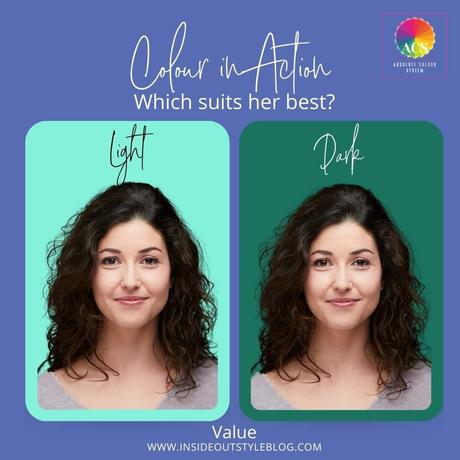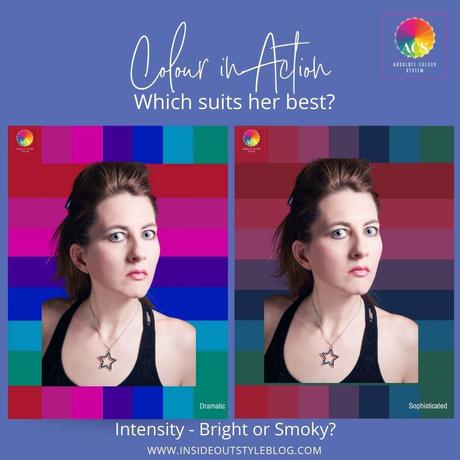Let's talk colour and personal colour analysis
Personal Colour Analysis (PCA) has been around for a long time now, yet it's developed a long way from it's original roots.
Back in the early 1980s Colour Me Beautiful by Carol Jackson took the world by storm and brought the concept of colour analysis to the masses. And it was a great start, but so many people didn't fit into one of only 4 seasons, as complexions and colouring are way more nuanced than just 4 palettes. Plus this system was developed in a very Caucasian world, where many skin tones were not thought about.
This is why since then various models of PCA have been developed, many seasonal systems now have around 12 palettes and so do many tonal models (which use the properties of colour - undertone, value and intensity as their basis), yet after 5 years of draping hundreds of clients in Australia, which is a very multicultural place colouring wise, I found them lacking and had started figuring out where all the gaps were in the existing systems.
This is why I developed my Absolute Colour System of 18 colour palettes, as I wanted to ensure that there were palettes that fit every different skin tone and colouring.
It's more nuanced and gives more options so that you can find your best palette rather than fitting yourself into one that's OK, but doesn't feel quite right.
The foremost thing to know about colours is that they should be in harmony with you. They should look like you rather than taking attention away from you. They should enhance your complexion rather than dull it or overwhelm it.
Think of colour like a picture frame. The frame is there to make the picture look good, but it's not the star, the picture is the star. The colours you wear should make you look great, but they shouldn't be all that people see as then this creates a body focus rather than a face focus.
3 Properties of Colour
Let's look at these colour properties on which all colours can be categorised.
Undertone of Skin
Undertone - aka how warm (yellow based) or cool (blue based) a colour is. This is based on your complexion in PCA, as when you look ill it's your skin that looks pale and washed out or palid. Eye colour is secondary to skin, plus many blue eyes and brown eyes can be either undertone.
In the the image blow, notice how the cool green is in harmony whilst the warm green pops out - you see it before you see her.
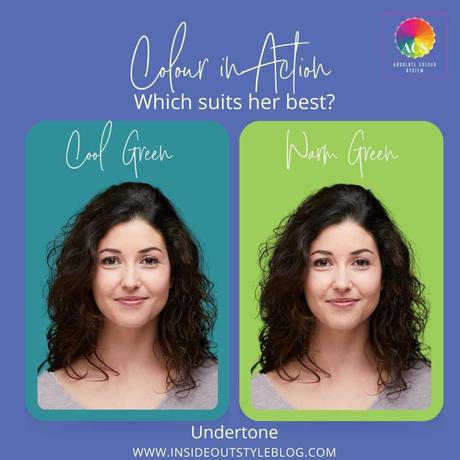
Compare then this image below with cool pink compared with warm orange. Notice how the cool pink jumps out as compared to the warm orange which blends with the woman's skin?
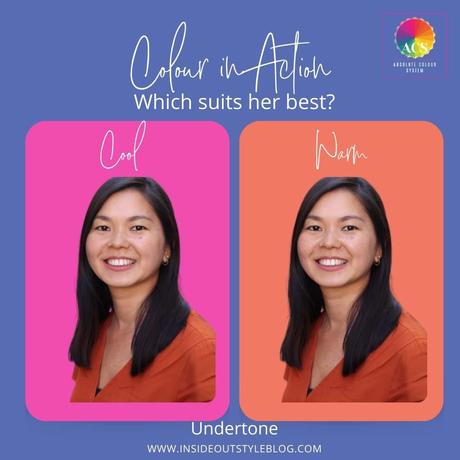
Many people use silver and gold to compare undertone, and it's more obvious the more you sit on the more extreme end of this continuum.
Here's a cool woman in silver and gold, notice how the silver blends, whilst the gold jumps out (plus it looks brassy next to her).
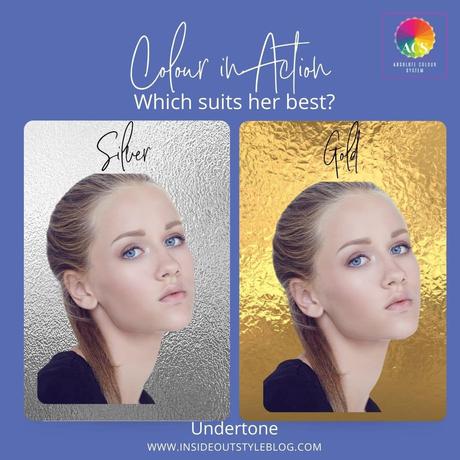
Compare that to someone who is warm (below) where the gold is in harmony whilst the silver is completely unrelated to her colouring.
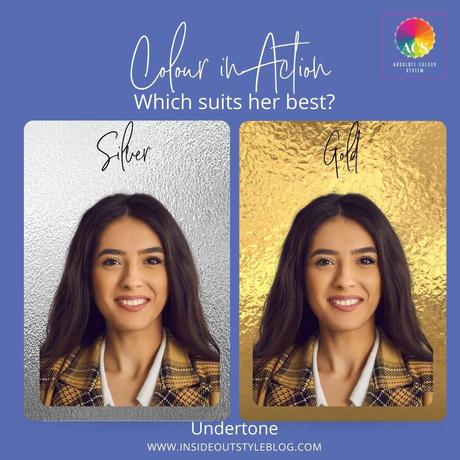
Here's an example using my Absolute Colour system virtual drapes below. Notice how the cool Dramatic palette colours on the left seem completely unrelated to her colouring, whilst the warm Rich colours on the right are in harmony with her skin tone?
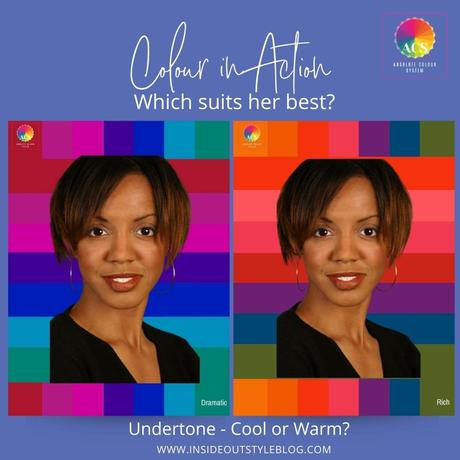
Value of the Colour
Value is just the technical colour term that means how light or dark a colour is (you can make a colour darker by adding black, and make it lighter by adding white).
Value relates to the colour of your hair and how light or dark it is. When wearing colours that are in a similar value to your hair, you'll always look your best.
Here's our lovely woman in green - comparing two cool greens (so the undertone is correct, we are just comparing value now). Notice how the lighter green jumps out (takes attention away from her) whilst the darker one makes her the star?
While in this example below, the fair hair demands lighter colours rather than darker ones which look heavy on her.
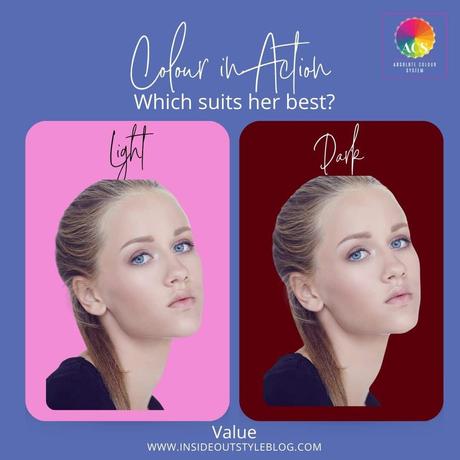
Here's an example looking at a more specific palette drapes. Notice how the Refined palette which is light and cool enhances her and looks balanced, whilst the dark Mysterious palette is too heavy and overwhelms her lighter features?
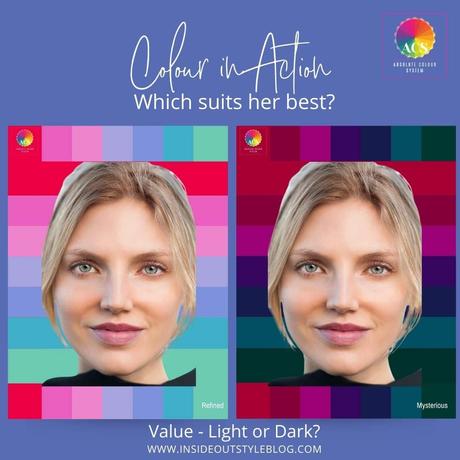
I call finding colours in the same value as your hair, your ideal value, as it's the optimal value for more of your outfit to be in.
Notice in the two images below, that on a light value person, the dark colour dominates and looks heavy, whilst the light colour is in balance.
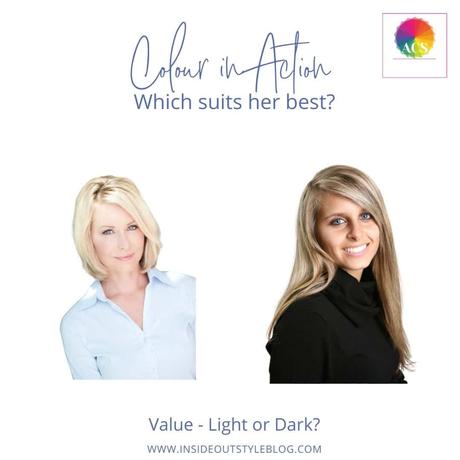
Intensity of Colours
The intensity of colours relates to how bright or muted/smoky/greyed-down a colour is. You are looking for colours that are as bright as you without overwhelming you.
Here below is an example of a soft smoky pink compared to a bright pink, both are in the correct undertone for the woman, but the bright pink wears her, whilst she wears the smoky pink.
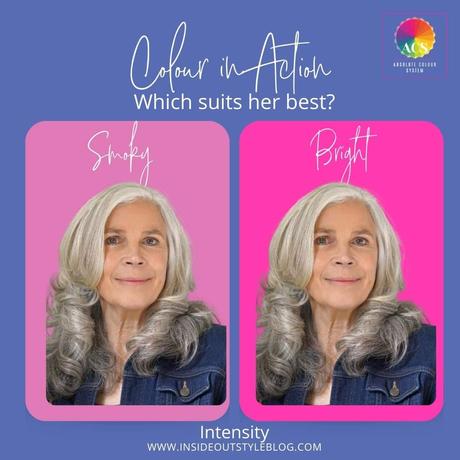
Here below is another example of intensity at work. And just a quick pointer, just because you have grey hair doesn't automatically mean you are cool. If your skin remains warm, then you're best in warm colours.
Again you can see the smoky orange is in balance with her while the bright orange wears her, she disappears and the frame is the star.

With the Absolute Colour System palettes, you can see the same concept at work. The bright colours ar in harmony with her clear skin and bright eyes, while the muted ones look drab and old. The brighter orange isn't terrible because it's in the correct undertone for her skin, it's just that it overwhelms her smoky colouring rather than providing a beautiful frame for it.
When the Colours Work
You are looking at balancing and finding harmony with each of these colour properties. The colours should look like the person, they are inherent in their colouring.
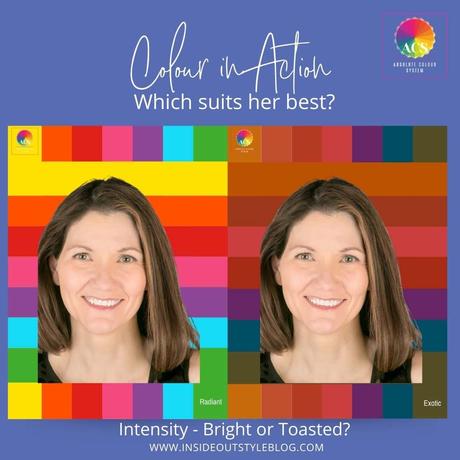
They should blend, rather than stand out. Notice how in the image above the bright Radiant palette colours look more like clown colours, whilst the Exotic palette blends in harmony with her colouring.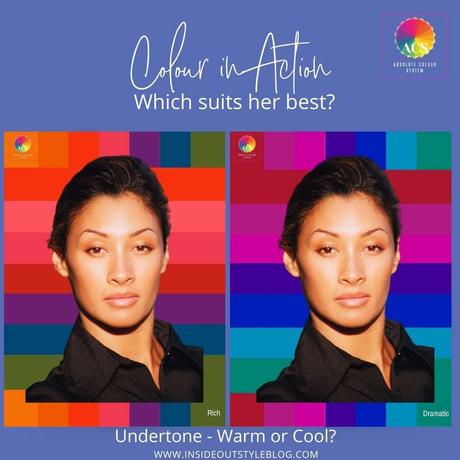
You should see the whole person, rather than just want to look at the colour. Here the Dramatic palette colours don't appear to be related at all while the warm Rich palette look gorgeous and resonate with her skin.
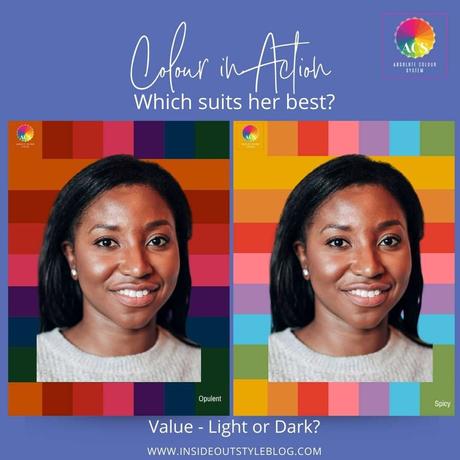
You can see in these examples just how on a dark person, light colours stand out rather than blend. The Opulent palette balances whilst the Spicy pulls the focus away from this gorgeous woman.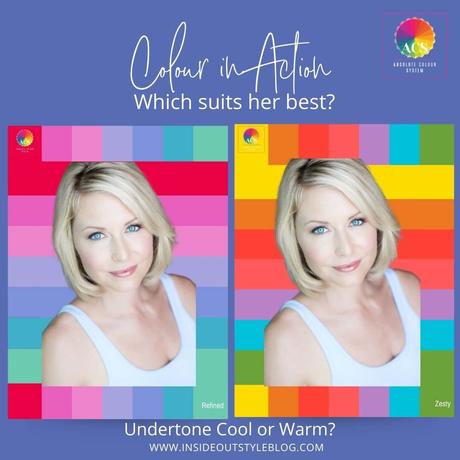
On a warm person, the cool colours pop, and vice versa, on a cool person the warm colours pop (just like this Zesty palette pops whilst the cool Refined palette is in balance).
And then intensity, these should be neither feeling too muted or dull (drab) or to bright and focus pulling.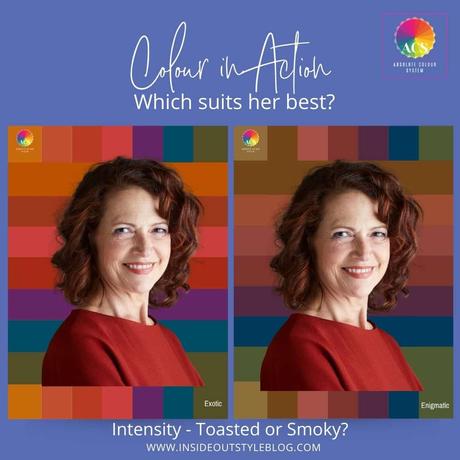
Here is a more nuanced example of how the lightly Toasted Exotic colours are more in harmony rather than the more smoky Enigmatic colours which look too drab.
When you have each of these 3 properties in sync with you, your outfits will look so much better as they create a beautiful frame that supports and enhances you and make you shine!
Discover Your Ideal Palette of Colours
If you'd love to discover your best palette of colours from my naunaced Absolute Colour System, then I'd love to do your personal colour analysis. What's great is that no matter where you live, I can do it for you online. Find out more here about one-to-one colour analysis or if you'd like to get a complete education in colour and style then I invite you to join my 7 Steps to Style program.
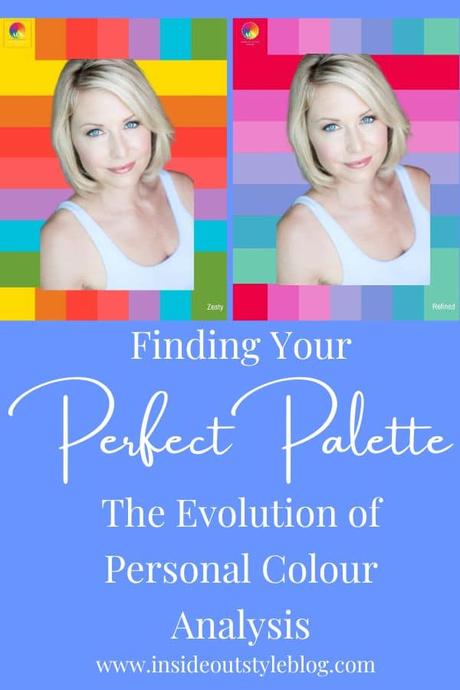
Further Reading
Personal Colour Analysis: The Hot New Old Trend
Why Colour Analysis has Evolved Beyond the Seasons
Understanding Colour Systems and Personal Colour Analysis
When Your Colour Analysis Result Is Not What You Expected

